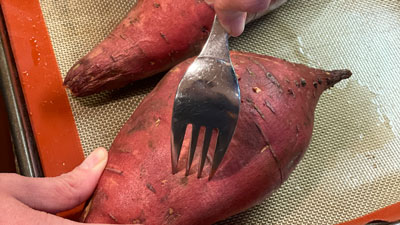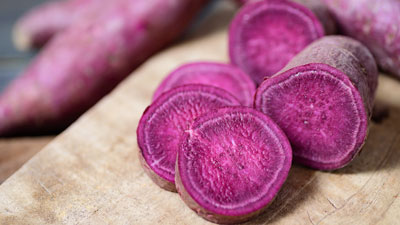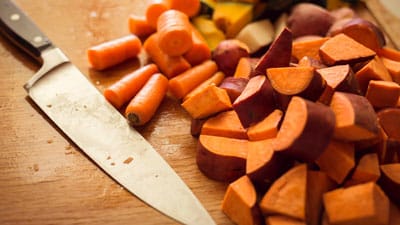
Sweet potatoes are so nutritious and easy on the palate, that they’re regarded as one of the world’s top 10 foods. Their sweet, creamy consistency makes it a favorite for anyone, from babies who are just getting started with solids, to older kids and adults. Even our furry family members (cats and dogs) love them and they are great for them too!
While the most common sweet potatoes are orange, they come in different colors and shades, from yellow all the way to red and purple. Recently, purple sweet potatoes have gotten a lot of attention due to their role in the Okinawan diet — Okinawa is one of the Blue Zones or geographic locations with the most centenarians around the world. – However, both orange and purple sweet potatoes are a top dietary component in the Blue Zones.
Orange sweet potatoes are rich in beta-carotene, a strong antioxidant and the plant-based precursor of vitamin A. Therefor, they support our vision, our cells in general, the production of white cells, and our organs. Purple sweet potatoes are rich in anthocyanins, a powerful antioxidant. Both are rich in fiber and resistant starch which are important to maintain a healthy microbiome. And they are rich in vitamin B2, vitamin B5, vitamin B6, vitamin C, copper, manganese and potassium. This means, they strongly support our immunity, metabolism, red blood cells, brain, heart, bones, muscles, and our children’s early development.
Check out our interactive page to learn more about how sweet potatoes can support your family’s well-being, and to learn some important tips and tricks to prepare them.
Sweet Potato Nutrition Calculator
Take a look at all the nutrients you and your family can get from eating sweet potatoes, with our Personalized Nutrition Calculator!
Nutritional needs vary according to age, sex, and whether women of reproductive age are pregnant or breastfeeding. Fill out the form below for yourself and for your family members to get a clear idea of the nutrition you can all get from this delicious vegetable.*
* Calculated as a percentage of the Recommended Daily Allowances (RDAs) as established by the U.S. Department of Agriculture and the U.S. Department of Health and Human Services. Based on nutritional information provided by the U.S. Department of Agriculture as an average of multiple sweet potato samples.
Sweet Potato Cooking Tips
How to Select & Store

Choose sweet potatoes that feel firm. No need to get organic, since they are on the Clean 15 list! But still, be sure to rinse them well before cooking. Store in a dark, cool, place instead of refrigerating to lower acrylamide formation.
Poke Before Baking

If you’re baking them, it’s a good idea to poke them multiple times with a fork. This helps the steam escape and prevents a sweet potato explosion in your oven!
Bake with Water

A dry environment with high heat levels leads to the formation of AGEs (Advanced Glycation End Products) which can affect our blood glucose. Bake them at 350° F or lower, and include a bowl of water to add humidity.
Keep the Skin

If you’re boiling your sweet potatoes, keep the peel to reap all that antioxidant power. Typically, they’ll be cooked in 10 to 15 minutes (when cubed). Test them with a fork, if it comes off easily, they’re ready. Add them to soups with other vegetables, grains or legumes!
Great for Babies!

Sweet potatoes make a fantastic first solid for your baby! Simply mash your baked or boiled sweet potato and give it to them. They’ll love it! Don’t include the skin as it can pose a choking hazard. Store in your fridge for up to 3 days, or freeze for up to a month.
Prrrrfect for Pets!

Dogs and cats love sweet potatoes too! Whether you bake them some yummy treats or simply give them baked or boiled cubed, they will devour them! Avoid the skin because it’s hard for our furry friends to digest it.
How Sweet Potato Supports Our Body
Sweet potatoes are packed with nutrients that support different parts of our body. Hover over each pointer to see how each body part uses these nutrients. Click on a pointer to visit that body part’s interactive page with further information about the nutrients it needs to thrive, the best whole-food plants to find them, and some interesting facts. Currently we only have Our Heart, Our Brain and Our Bones pages ready. Come back soon for more!

Our White Blood Cells
Sweet Potatoes are a packed with vitamin A, which stimulates the production and activity of our white blood cells. It’s rich in immune system supporting nutrients like vitamins B2, B6, and C, plus copper and manganese.Our Red Blood Cells
Sweet potatoes are a great source of vitamins B2, B6 and C. Vitamin B2 helps us produce red blood cells while vitamin B6 helps us produce hemoglobin, the protein in red blood cells responsible for delivering oxygen to tissues. Vitamin C helps us absorb iron better, which is also important to produce hemoglobin.Early Development
Vitamin B2 supports early development as a whole. Vitamin B6 and copper support early brain development.Our Eyes
Sweet potatoes are a top source of vitamin A, which helps prevent eye dryness that can lead to blindness and night blindness. It’s also rich in vitamin B2, which helps prevent cataracts.Our Brain
Vitamin B1 helps our overall brain health. Vitamin B6 helps us prevent cognitive decline, including Alzheimer’s, as we age. It also helps with mood regulation and pain inhibition. Copper helps with the formation of neurotransmitters. Vitamin C supports information processing.Our Metabolism
Vitamin A, vitamin B2, vitamin B6 and manganese support our metabolism, which is our body’s ability to turn our foods into energy for our cells.Our Lungs
Vitamin A is very important for our lung health, particularly during early development.Important Things to Know
Sweet Potato vs Potato








